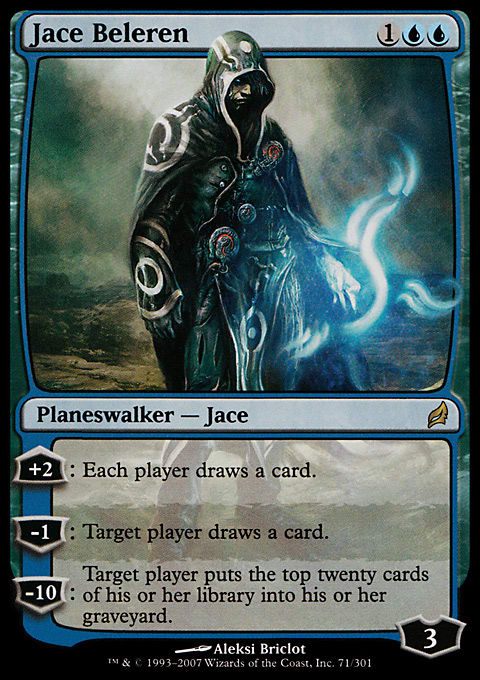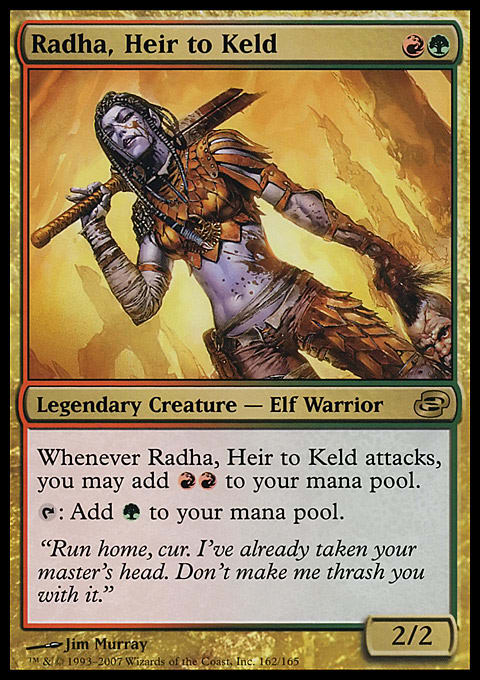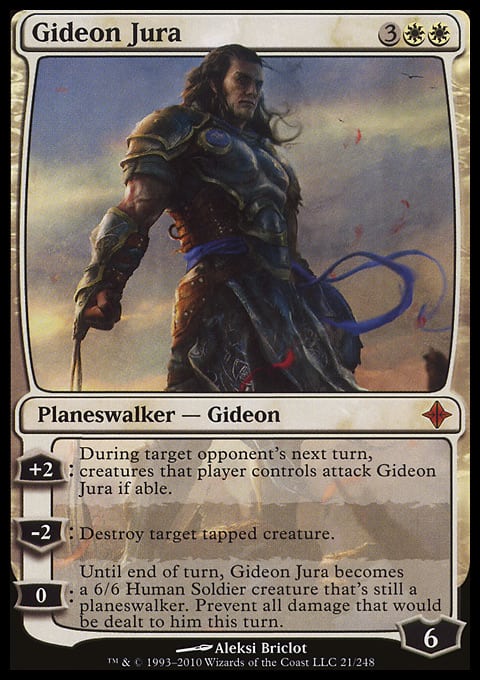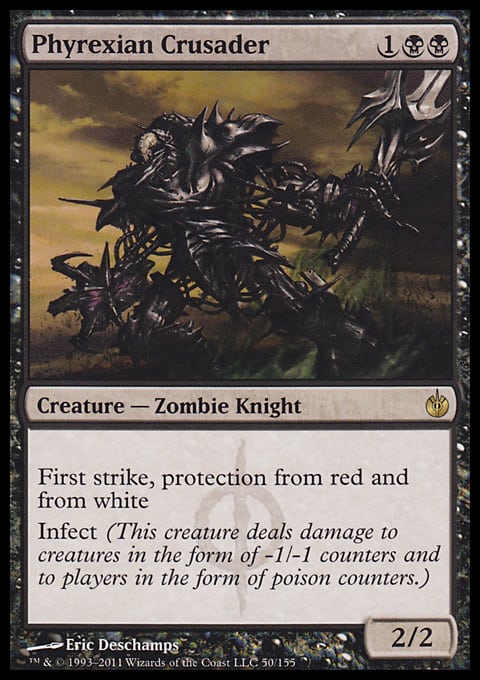This week, Daryl Bockett, Jules Robins, Brendan Weiskotten, and I coordinated our articles to focus on planeswalkers. Each of our articles plays to its author’s strengths. Daryl’s an expert on multiplayer interaction given that he has a Ph.D. in International Relations; as far as I know, that background’s unique among all Magic writers ever. Jules is omnivorous, having written about Commander and Magic design while also grinding on the Pro Tour Qualifier circuit. Wizards of the Coast brings teams together to design for various demographics, but Jules is basically all the demographics at once, and that’s who you want writing about design. Brendan’s been a Vorthos voice for years, building lore before turning recently to a community-driven column; he too is omnivorous.
So, what’s my strength? Ummm . . . right. At best, I’m a dilettante savant; at worst, I’m just inconsistent. Though I’m far from alone as a lawyer who writes about Magic—you can get a longer career from Bruce Richard or more Pro Points from Tom Martell and Matt Sperling should you want better qualifications than mine—I can use the skill set to point out internal inconsistency. Inconsistent testimony lets defendants go free; inconsistent facts and arguments might lead a party to settle. I guess I’m trained in inconsistency analysis . . . even though that’s not a term.
This is my inconsistency analysis on planeswalker flavor and marketing, for what it’s worth.
The hierarchy used to be simple. In having a variety of spells at your disposal from every known corner of the multiverse, you were one of the most powerful beings in existence. You weren’t automatically awesome—Urza and Tevesh Szat still could do far more than you by dint of their age and experience, and presumably they didn’t open junk rares—but you were working on it at least.
Since 2007, the planeswalker concept has moved from a player concept to a card type and marketing build-around. I say moved. It hasn’t moved so much as expanded to the point of strange conflations. Currently, Magic intellectual property sells the idea of you and purchasable cards as planeswalkers. The more I think about it, the more I think this is unclear and a major hit for flavor.
This isn’t due to an overgrown fictitious universe where every addition to the canon is a chance to jump the shark. Many franchises have fallen to that problem, but the player–planeswalker concept has remained consistent through being open-ended. No, the problem is that subsequent developments, consistent in themselves, give a different impression of planeswalkerdom than previous internally consistent concepts. It’s possible that the problem is irreconcilably large, but it’s worth exploring conflicting concepts of Magic branding. My primary goal is to compare player planeswalkers to card planeswalkers across the brand to see which concepts resonate where.
Why Are You Being a Player-Flavor-Hater?
The biggest current resource for planeswalker explanation and branding is here. Maybe I have to be a Vorthos (or, more basically, like fiction) to understand this stuff, but it doesn’t make sense to me.
The site says that “[p]laneswalkers are unique in their ability to move from one world to the next[.]” Sure thing, at least in terms of what can travel of its own volition. But if battlefields belong to a place—and while I don’t know much about that, presumably you’re on one battlefield at a time—how do you transfer things between planes when “Mortal beings without the Planeswalker spark are soon destroyed” if they enter the space between planes (the Blind Eternities)? Planechase gets the idea right of players moving across planes to fight an epic war, but it says nothing of how you can pack up all your summoned creatures to go to the next plane. Maybe that’s what when-you-planeswalk triggers can represent; if so, great. But if I brought my battlefield to another plane, there would be a lot of attempts to fit things into suitcases and calls to say I’m going to be about ten minutes late. If planeswalkers were completely unique in their ability to move among planes, they couldn’t take their stuff with them.
Surprisingly, this gives planeswalkers and battlefields the most flavor sense in expansion set Limited. Quick, there’s a battle! You need to learn as much about this plane as you can before you’re dead! The battlefield is in a specific world, the stuff is known to thrive on that plane, and you’re fighting in places named on the cards. It becomes more complex, perhaps hopelessly so, after that.
In terms of these concepts, card planeswalkers are superior. Their storylines involve them teleporting for a world-specific purpose; we know, for example, why Sarkhan went to Zendikar. (The wizards.com page linked above has the basic stories for each planeswalker.) Even Tamiyo’s information-gathering, generic as it is, explains her existence on Innistrad. Card planeswalkers’ objectives are definable and focused; as such, they make better standalone planeswalkers than players do. If their abilities are designed properly, they will be optimal in decks fitting their initial flavor. Planeswalkers who developed specific skills make more sense as beings than player planeswalkers who could do just about anything. It might become more confusing as we see more than three iterations of the same card planeswalker, but even then, it still will work better on the cards than with humans.
Ignite Whose Spark?
While that bit of branding could cut either way, other parts on the same page are unequivocally referring only to card planeswalkers. “[T]he spark” exists in “one in a million sentients,” and not everybody uses his or her spark. This works out to around seven thousand living humans, so they’re not referring to players at this point (despite coming the paragraph after “You Are a Planeswalker”). It seems clear that this part of planeswalker flavor was written after the development of card planeswalkers.
“The Blind Eternities” and “The Life of a Planeswalker” paragraphs, describing the space and function of a planeswalker, are generic enough to apply to either player planeswalkers or card planeswalkers, although plane-hop survival is still a problem with player flavor. Card planeswalkers win this flavor issue again for having an itinerant spirit hardwired into their flavor, implying light travel. Venser has a journal, not an entourage; it makes sense. I assume there were a number of ways to include players in this flavor, but the choices made favor the cards.
My conclusion from the page by itself is that players aren’t planeswalkers. The normal rule of textual interpretation here is to interpret the general statements by the specific ones, and the specifics all point to the card planeswalkers as what makes sense. The fact that it says “Ignite Your Spark” and “You Are a Planeswalker” doesn’t mean they’ve supported those statements with anything. When you are playing Magic, you’re not like Gideon, Jace, or Tibalt. They have specific purposes and motivations that lead them to certain types of spells, as core set cards such as Jace's Erasure and Gideon’s Depeche Mode Lawkeeper tell you what those planeswalkers want to do. (I’ve been waiting to make an Erasure joke for a long time . . . just give it a little respect.)
The Flavor of Competition
There have been five Duel Deck sets based on planeswalker antagonism: Jace vs. Chandra; Garruk vs. Liliana; Elspeth vs. Tezzeret; Ajani vs. Nicol Bolas; and Venser vs. Koth. That’s the majority of card planeswalkers set against each other, though their levels of opposition vary. Many of these opponents treat each other like they have cooties, especially Liliana, who gave Garruk curse cooties. They don’t want to be on the same side of anything.
But as you build your library of spells, you can include Garruk and Liliana in the same deck without penalty. Worse for flavor, a Garruk, the Veil-Cursed/Liliana of the Veil deck would be pretty good. Garruk could make creatures while everyone else has to sacrifice something they worked hard for. Liliana can make everyone discard, but eventually, Garruk can tutor for a creature, lessening the need for cards in hand. The mana would be tougher for Garruk, Primal Hunter and Liliana of the Veil, but Garruk’s card-draw looks nice next to Liliana’s discard.
From what I see, there is no battle a player can engage in that would convince Garruk and Liliana to play together. And that’s part of the problem with players as planeswalkers: No amount or type of branding can convince me that—when I battle in a card shop, my apartment, or even seated to Pat Chapin’s immediate left in a Grand Prix match—I am doing something epic. “In the end, I just can’t shake off this damnable sense of perspective.”
On top of that, the storylines make clear why card planeswalkers are bothering to fight each other. Major problems keep happening. Some things need to be killed. Sometimes, they need to be killed because of another planeswalker’s villainy (looking at you, Nicol Bolas), but planeswalker battles are part of an archetypal crisis-response cycle. That leads to the problem of when player planeswalkers choose to fight each other. If I say, “Fancy a game?” then by this flavor, I’m just picking a fight, making me some combination of a villain and gratuitously violent, a.k.a. what reactionary people think Magic players are. If I put as much emotion into the game as the card planeswalkers do in saving planes, I’d be a terrible winner and a sore loser. That’s not what WotC intends—again pushing player concepts away from planeswalkers.
The Other Side of the Divide: Limits of a Card
So far, I’ve referred mostly to the storyline to get an idea of card planeswalkers. The problem with that approach is that it ignores how we most frequently engage a planeswalker: by his or her loyalty abilities. With planeswalker function restricted by a number of text lines, all the cards can be are greatest-hits compilations (Now That’s What I Call Activated Abilities!). They’ve tried to work out the flavor on this limitation by posturing card planeswalkers as mana mercenaries. There’s only so much they’re available for, and they’ll probably leave earlier than you want—like your friend who digs chillaxing with you but has work the next day.
Here, and possibly only here, player planeswalkers capture the range and potential of spellcasting better than card counterparts. Good decks require forethought and a variety of threats and answers; there’s a preparation aspect to decks that perfectly encapsulates the flavor. The gameplay issues that would get in the way—why you can only take four of something that isn’t Relentless Rats and why you can’t summon your most powerful things all the time—take a backseat to the resonance between deck building and battle preparation. A single card or character can’t express that concept.
Is There a Solution?
The bottom line is that WotC has succeeded on every possible level with the basic flavor of card planeswalkers so brightly that there’s a permanent shadow over how a player can be a planeswalker. “You Are a Planeswalker” feels like leftover marketing or like some unused levels left in the NES cartridge. There’s just no good link left to it anymore.
So, are players planeswalker overlords? Puppet masters of a Tommy Westphall Universe where each plane is a separate snow globe? (Ulgrotha even sounds like the name of an old lady who would hoard snow globes.) If they can’t be planeswalkers in modern parlance, what can they be?
I think the spirit of planeswalkers as travelers engaged in a plane’s turmoil when it suits them makes sense for players, but that can be fleshed out in a more containable and defensible concept than labeling players as planeswalkers. To me, it makes the most sense to sell to players that they can shape the outcome of battles in an existing storyline—akin to the Choose Your Own Adventure series or Magic 2012’s “Gather Your Allies”—and that their victories are a representation of how those battles end.
Since Ravnica’s on the schedule this year, imagine for a moment that you’re living in Ravnica. All the guilds are lined up, but you have the choice of which one you want to belong to. Maybe you have strong sympathies to one, in which case your spells (thought of as activities, I guess) would contain plenty of guild members and tendencies. Maybe you’re too ecumenical for the guild system and want to take the best parts of various guilds. Whether you join an existing organization in Ravnica or create your own independent one, your choice of cohorts (deck) and deployment (play style/skill) tilt the power balance in Ravnica to your desired ends when you succeed.
Ravnica is the clearest examples, but expansion sets always have enough locales to provide enough new annual flavor for this player concept. Magic sets by necessity tend to leave details open-ended; that gap would be a great place to stick player flavor.
This concept has some drawbacks—Why do you need to play again if you decided it in the first game?—but it ties into whatever block is current, it gives players a definite role as free agents, and it gives players a distinct flavor from the planeswalker concepts that have been moved from under them. Given that there’s a new Magic story every block, maybe there doesn’t need to be a unifying theory for all Magic of all time. As it stands, blocks are the micro to Magic’s macro, and players don’t have a sensible concept at the macro level. Shifting focus to a player’s role in each block would turn the micro into the macro for branding purposes. It at least would make more sense as a system than the current faux-overlap (fauxverlap?).
This Box Is for Players. This Other Box Is for Planeswalkers.
For now, planeswalker branding is nonsensical on its face. If branding were a statute and I were a judge, I’d save as much material as I could and strike down the rest. (This presumes the statute has a severability clause, but you probably don’t care.) The ideas surrounding the fictitious card planeswalkers have been developed through a system that makes sense both in its premises and follow-through. Card limitations are a defect in the system, but it’s currently compensated for pretty well. This leaves players as the group that needs a new, consistent, defensible concept. I don’t know if the concept’s out there, but not trying leaves a mess of the flavor on Magic’s ground floor. Over the last five years, we’ve developed a new understanding of what a planeswalker is. So what are we?





























